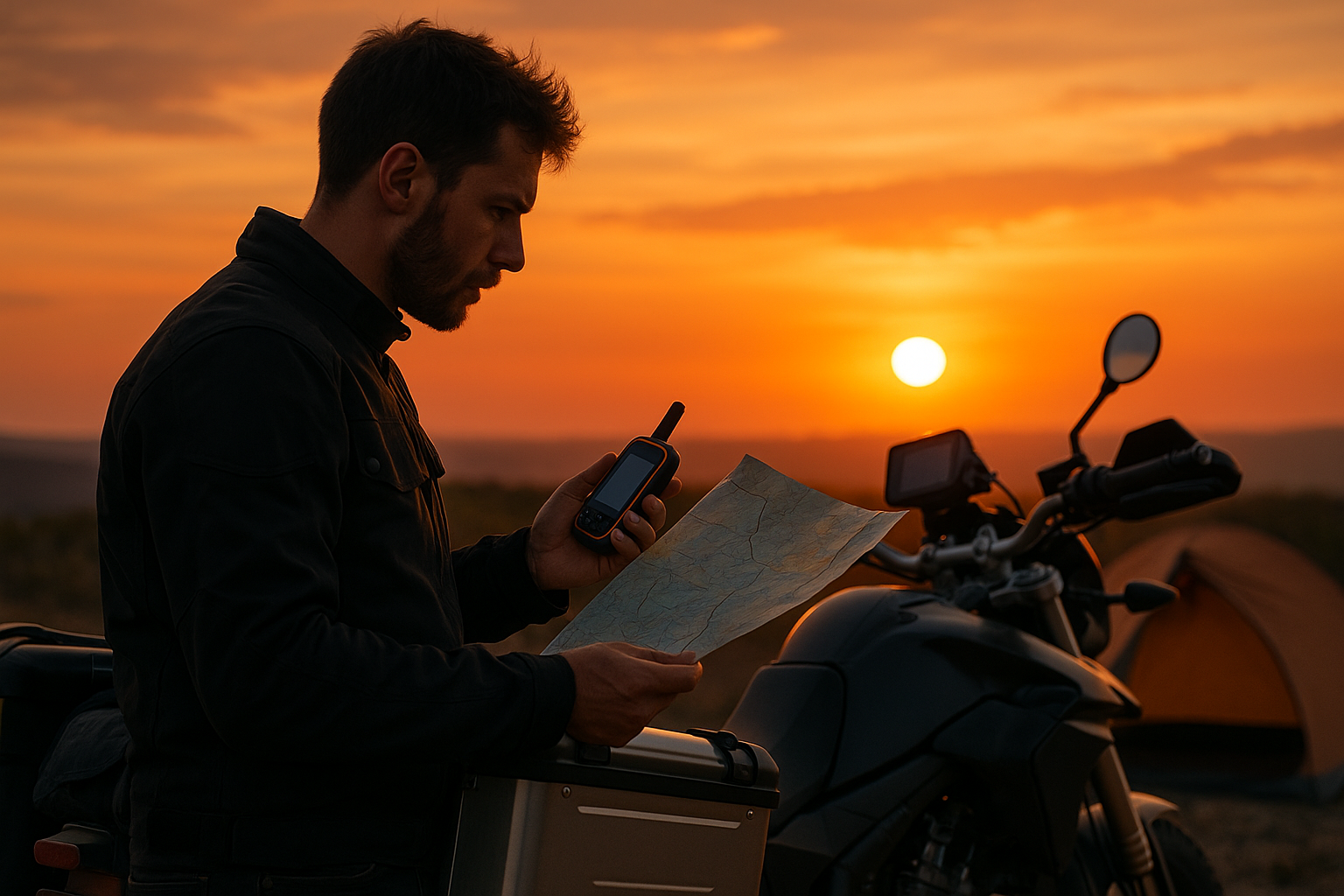Picture this:
You’ve been riding all day, exploring rugged trails and breathtaking backcountry views. Now, the sun dips behind the horizon, casting long shadows over unfamiliar terrain. Your campsite — the one you set up hours ago — has vanished into the growing dusk.
Lost at sunset during a motorcycle camping trip isn’t just frustrating; it can be dangerous. Darkness brings reduced visibility, disorientation, and a higher chance of accidents or wildlife encounters.
So, how do you navigate back to camp when the light fades and landmarks disappear? Forget basic compass-and-map advice. This guide dives into field-tested, innovative tools and techniques that experienced riders use to locate their camp — even in tricky conditions.
 The Real Problem: Navigating Back in Fading Light
The Real Problem: Navigating Back in Fading Light
Getting lost at sunset often happens because:
- You didn’t mark your route with visible, recognizable markers.
- The terrain looks different under changing light.
- Your navigation tools aren’t optimized for quick, low-light use.
- Fatigue after a long ride clouds your decision-making.
Let’s break down practical solutions that address these real-world challenges.

 Start Smart: Mark Your Camp Before You Ride
Start Smart: Mark Your Camp Before You Ride

Before you leave camp for a ride, place a brightly colored flag, a reflective bandana, or a small solar light at your campsite’s perimeter. These stand out in fading light and help you spot camp from a distance.

Use GPS apps like Gaia GPS, onX Offroad, or Google Maps offline to drop a precise pin on your campsite location. Make sure to save offline maps in case you lose signal in remote areas.

Before leaving, mentally note natural landmarks (like a uniquely shaped rock or a tree) near your camp. Snap a quick photo with your phone for reference — this simple habit can save hours of wandering.

 Carry Compact, Rider-Friendly Navigation Tools
Carry Compact, Rider-Friendly Navigation Tools

A tiny compass clipped to your jacket or tank bag can give you a general bearing back to camp. Glow-in-the-dark versions remain visible even after sunset.

Pack lightweight reflective trail markers (like thumbtack reflectors or glow sticks) that you can discreetly place along your route. They’re visible from both directions and don’t require batteries.

Devices like the Garmin eTrex 22x or Garmin GPSMAP 66i have a “backtrack” mode that digitally retraces your route. These tools are rugged, work without cell service, and let you focus on the terrain rather than your phone.

 Light the Way with Low-Profile Illumination
Light the Way with Low-Profile Illumination

Attach a red LED clip to your jacket, backpack, or helmet. Red light preserves night vision while making you visible to your own camp or riding partners.

A lightweight, adjustable headlamp (like the Petzl Actik Core) lets you illuminate the trail while keeping your hands free. Angle it downward to reduce glare and illuminate ground-level clues like footprints or bike tracks.

Compact lanterns like the Luci Outdoor 2.0 can charge during the day and provide wide-angle light at camp or while searching. Hang one at camp to create a beacon in the dark.

 Think Like a Tracker: Read the Terrain
Think Like a Tracker: Read the Terrain

In areas with soft dirt or sand, look for your own tire marks, especially where they diverge from other paths. Consider leaving a deliberate track signature—such as a loop or zigzag—that’s easy to recognize later.

Trust your senses. If you’re near water, listen for its sound. Smells from your camp kitchen or campfire can also guide you if the wind direction hasn’t changed.

If safe, climb a small hill or rock to get a better view. Scan for artificial lights, reflective gear, or familiar landmarks.

 High-Tech Navigation Backup
High-Tech Navigation Backup

Apps like Gaia GPS, Avenza Maps, and onX Offroad let you pre-load maps that work without cell service. Use them to navigate to your marked campsite pin.

Tools like the Garmin inReach Mini 2 or Zoleo Satellite Communicator offer GPS tracking, messaging, and SOS functions. Even if you’re disoriented, you can send your coordinates to a trusted contact or retrace your path.

 Emergency Protocols for When You’re Truly Lost
Emergency Protocols for When You’re Truly Lost

If you’re completely lost, don’t wander aimlessly. Find a safe spot, stay put, and signal for help using a whistle, reflective gear, or an emergency strobe. Wandering can make rescue harder.

Create a visible marker with gear or bright clothing, and set up your tent or tarp in an open area. Use a signal mirror or reflective tape if you spot a searcher or aircraft.

Ration water, snacks, and battery life while maintaining warmth. Avoid panic by focusing on small steps: shelter, signaling, and hydration.
 Real-World Rider Insights
Real-World Rider Insights
“I always carry a mini Garmin GPS that can retrace my steps. I also hang a reflective bandana from a tree at my camp—it’s old school, but it works.” – Jake S., adventure rider
“During my last desert trip, I left small reflective tacks on my return route. Without those, I would’ve spent the night trying to find my tent.” – Emily R., solo motorcycle camper
 Conclusion: Navigate Back Safely Every Time
Conclusion: Navigate Back Safely Every Time
Getting lost at sunset while motorcycle camping is more than a minor inconvenience—it can be life-threatening. But with a mix of practical tools, field-savvy strategies, and backup plans, you’ll always have a path back to camp.




Because no ride is worth getting lost in the dark.


